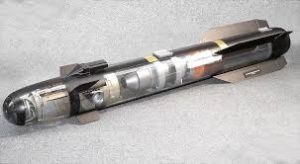US Hellfire missile:

A video has left Washington in disbelief after it appeared to show a US Hellfire missile bouncing harmlessly off an unidentified flying object (UFO) off the coast of Yemen.
- It is an air-to-ground, laser-guided, subsonic tactical missile with significant anti-tank capacity.
- It can also be used as an air-to-air weapon against helicopters or slow-moving fixed-wing aircraft.
- It is used by the United States military as well as 30 US allies.
- The United States began developing the AGM-114 Hellfire in 1972 to address the Army’s requirement for a helicopter-launched antitank missile to counter Soviet armor formations.
- The Air-to-Ground (AGM)-114 provides precision striking power against tanks, structures, bunkers, and helicopters.
- The Hellfire missile is capable of defeating any known tank in the world today.
- It is the missile of choice for several kinds of unmanned aerial vehicles (UAVs), such as the MQ-1B Predator, MQ-9 Reaper, and MQ-1C Grey Eagle.
- AGM-114 missiles measure between 1.63-1.75 m in length, 0.178 m in diameter, and weigh 45-48.5 kg.
- They have a range of 7-11 km while carrying a payload of 8-11 kg.
- The missile flies at subsonic speeds to a maximum of Mach 1.3 (450 m/s).
- It is propelled by a single-stage solid-propellant solid-fuel rocket motor.
- The missile can be guided towards the objective either from inside the aircraft or by lasers outside the aircraft.
- The AGM-114R multipurpose missile is the latest in the Hellfire II missile range.
- Also known as the Hellfire Romeo, the missile integrates the capabilities of all previous Hellfire II variants.
- It can be launched from several different kinds of fixed-wing aircraft and helicopters, surface ships, and military ground vehicles.
- It uses a semi-active laser guidance system and an integrated blast fragmentation sleeve warhead to engage targets that previously needed several Hellfire variants to destroy.




